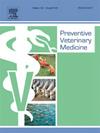利用潜在类模型评价猪胴体污染计算机视觉系统的性能
IF 2.2
2区 农林科学
Q1 VETERINARY SCIENCES
引用次数: 0
摘要
本研究评估了计算机视觉系统(CVS)的性能,该系统使用潜在类建模来测量猪胴体污染,这是一种不依赖于金标准的统计方法。由丹麦技术研究所开发的CVS集成了来自各种摄像机的输出,以检查猪尸体是否存在粪便污染。分析了为期16天的69,215具尸体的数据,并将CVS结果与官方辅助机构的数据进行了比较。描述性分析确定了四个肉类检查结果,这些结果与CVS阳性的相对风险增加有统计学关联,特别是油污染(RR = 4.1, P <; 0.001),CVS无法将其与粪便污染区分。使用Cohen 's kappa和患病率及偏差调整kappa (PABAK)评估CVS与官方辅助之间的一致性,Cohen 's kappa表示最小一致性(κ = 0.17), PABAK表示中等一致性(κ = 0.79)。敏感性和特异性使用贝叶斯框架内的潜在类别模型进行估计,而不假设CVS或官方辅助测试是完美的测试。的类模型表明,CVS平均灵敏度31.6 %(95 % CI: 27.6 % -39.1 %)和特异性97.9 %(95 %置信区间:96.1—-99.9 %),而22 %(95 % CI: 17.6 % -28.9 %)敏感性和99 %(95 % CI: 98.2 % -100 %)特异性的官方助剂。这些发现强调了CVS在检测真正的污染和官方辅助排除非污染的能力方面的优势。本研究证明了潜在类模型对评估CVS的适用性,提供了一个灵活可靠的框架,解决了传统金标准方法的局限性。研究结果支持将CVS技术与传统检查一起使用以提高食品安全,为未来将CVS整合到肉类检查中铺平了道路,等待立法调整。本文章由计算机程序翻译,如有差异,请以英文原文为准。
Using latent class modelling to evaluate the performance of a computer vision system for pig carcass contamination
This study evaluates the performance of a computer vision system (CVS) for measuring pig carcass contamination using latent class modelling, a statistical approach that does not depend on a gold standard. Developed by the Danish Technological Institute, the CVS integrates output from various cameras to inspect pig carcasses for presence of faecal contamination. Data from a 16-day period involving 69,215 carcasses were analysed, comparing CVS results with those from official auxiliaries. Descriptive analyses identified four meat inspection findings that were statistically associated with an increased relative risk of positives from the CVS, particularly oil contamination (RR = 4.1, P < 0.001), which the CVS could not differentiate from faecal contamination. Agreement between the CVS and official auxiliary was assessed using Cohen’s kappa and prevalence- and bias-adjusted kappa (PABAK), with Cohen’s Kappa indicating minimal agreement (κ = 0.17) and PABAK indicating moderate agreement (κ = 0.79). Sensitivity and specificity were estimated using a latent class model fit within a Bayesian framework, without assuming that either the CVS or official auxiliaries were perfect tests. The latent class model showed that the CVS had a median sensitivity of 31.6 % (95 % CI: 27.6 %-39.1 %) and specificity of 97.9 % (95 % CI: 96.1–99.9 %), compared to 22 % (95 % CI: 17.6 %-28.9 %) sensitivity and 99 % (95 % CI: 98.2 %-100 %) specificity for the official auxiliaries. These findings underscore the CVS’s strength in detecting true contaminations and official auxiliaries’ ability to rule out non-contaminations. This study demonstrates the applicability of latent class modelling for evaluating CVS, offering a flexible and reliable framework that addresses the limitations of traditional gold standard methods. The findings support the use CVS technology alongside traditional inspections to enhance food safety, paving the way for future integration of CVS in meat inspection, pending legislative adjustments.
求助全文
通过发布文献求助,成功后即可免费获取论文全文。
去求助
来源期刊

Preventive veterinary medicine
农林科学-兽医学
CiteScore
5.60
自引率
7.70%
发文量
184
审稿时长
3 months
期刊介绍:
Preventive Veterinary Medicine is one of the leading international resources for scientific reports on animal health programs and preventive veterinary medicine. The journal follows the guidelines for standardizing and strengthening the reporting of biomedical research which are available from the CONSORT, MOOSE, PRISMA, REFLECT, STARD, and STROBE statements. The journal focuses on:
Epidemiology of health events relevant to domestic and wild animals;
Economic impacts of epidemic and endemic animal and zoonotic diseases;
Latest methods and approaches in veterinary epidemiology;
Disease and infection control or eradication measures;
The "One Health" concept and the relationships between veterinary medicine, human health, animal-production systems, and the environment;
Development of new techniques in surveillance systems and diagnosis;
Evaluation and control of diseases in animal populations.
 求助内容:
求助内容: 应助结果提醒方式:
应助结果提醒方式:


